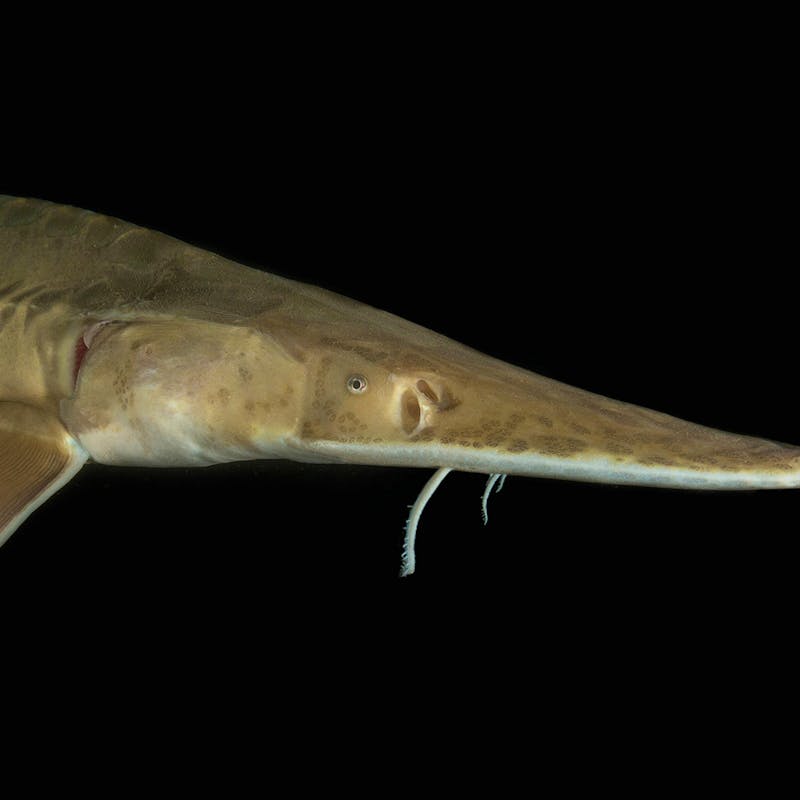Melanie Gade: mgade@defenders.org (202) 772-0288
Angela Guyadeen: Aguyadeen@NRDC.org (312) 651-7936
Feds Proceed with Dam Construction on Yellowstone River, Putting Last Wild Population of Ancient “Dinosaur” Fish at Risk
The Bureau of Reclamation (Bureau) and the U.S. Army Corps of Engineers (Corps) announced they will build a concrete dam across the lower Yellowstone River near Glendive, Montana. The dam will cause irreparable harm to the nation’s largest wild population of endangered pallid sturgeon, an ancient fish species with ancestors dating back to the time of dinosaurs, living in the upper Missouri and Yellowstone Rivers as well as several other fish species using the lower Yellowstone.
These rivers provide the best remaining habitat in North America for the pallid sturgeon, a giant fish which grows up to six feet in length and lives 50 years or more. For decades, this sturgeon population has been unable to successfully reproduce in the wild because dams have altered and cut off access to important habitat for the fish and its young.
In February, Defenders of Wildlife and the Natural Resources Defense Council (NRDC) filed a lawsuit charging the Bureau, the Corps, and the U.S. Fish and Wildlife Service (FWS) failed to comply with the Endangered Species Act (ESA) in operating two dams in the upper Missouri River Basin that are endangering the pallid sturgeon.
One of the two dams, Intake Diversion Dam on the Yellowstone, is currently a porous rock weir, built a century ago, to force water into an irrigation canal. The Corps and Bureau plan to replace this structure with a concrete dam, two feet higher, more substantial and permanent. The Corps and Bureau also plan to fill in a natural sidechannel, that currently allows some fish passage around the rock weir, and replace it with an artificial bypass channel for fish passage, even though fish biologists believe it is unlikely sturgeon will be able to use it. FWS has stated that if the Corps builds the unproven fish bypass channel at Intake, it will not have to modify its operations at Fort Peck Dam on the Missouri River as previously required under the ESA. Fish biologists say these modifications at Fort Peck are critical for pallid sturgeon recovery.
In response, Defenders of Wildlife and NRDC intend to amend their current lawsuit to challenge the agencies’ authorization of the new dam for failing to comply with federal environmental laws.
Steve Forrest, senior representative for Defenders of Wildlife’s Rockies and Plains Program, issued the following statement:
“We’re asking the court to call time-out on this project until the agencies have completed the legally required studies and reconsidered the irreversible harm that will follow if the Yellowstone River is permanently blocked to fish migration. With valuable taxpayer dollars at stake, we’d like to see solutions that guarantee passage for the sturgeon and other fish while also delivering irrigation water. We’re not going to stand by while these agencies cause irreversible harm to pallid sturgeon and to this last great naturally flowing river in the lower 48 states.”
Marcus Griswold, Water Resources Scientist for Natural Resources Defense Council, issued the following statement:
“We need to have an honest dialogue to find solution that will preserve the river’s historic, natural integrity, while providing reliable water to the communities and ecosystems that depend on it for survival. The initial federal plan was endorsed and embraced by the local community but instead local taxpayers are now stuck with this expensive option that doesn’t meet the original goals. These agencies need to revisit the drawing board -- otherwise it’s hook, line and sinker for the pallid sturgeon and local taxpayers.”
Background: The Intake Diversion Dam on the Yellowstone River – a major tributary of the upper Missouri River – blocks pallid sturgeon from reaching critical spawning grounds, while issues with the timing and temperature of water releases from the Fort Peck Dam destroy the sturgeons' spawning and rearing habitat in the main stem Missouri. Any eggs that hatch are sent downstream to suffocate, starve or become food for larger fish in Lake Sakakawea. Together, these dams prevent the pallid sturgeon from successfully reproducing in the upper Missouri River basin. As a result, the wild population in the basin – the most important population of pallid sturgeon remaining for recovery – is dying out. Approximately 125 wild fish remain, all nearing the end of their lives. The Service listed the pallid sturgeon as an endangered species on September 6, 1990.
###
Defenders of Wildlife is dedicated to the protection of all native animals and plants in their natural communities. With more than 1.2 million members and activists, Defenders of Wildlife is a leading advocate for innovative solutions to safeguard our wildlife heritage for generations to come. For more information, visit www.defenders.org and follow us on Twitter @defendersnews.
The Natural Resources Defense Council (NRDC) is an international nonprofit environmental organization with more than 1.4 million members and online activists. Since 1970, our lawyers, scientists, and other environmental specialists have worked to protect the world's natural resources, public health, and the environment. NRDC has offices in New York City, Washington, D.C., Los Angeles, San Francisco, Chicago, Bozeman, MT, and Beijing. Visit us at www.nrdc.org and follow us on Twitter @NRDC
For over 75 years, Defenders of Wildlife has remained dedicated to protecting all native animals and plants in their natural communities. With a nationwide network of nearly 2.1 million members and supporters, Defenders of Wildlife is a leading advocate for innovative solutions to safeguard our wildlife for generations to come. To learn more, please visit https://defenders.org/newsroom or follow us on X @Defenders.
Media Contact
News

Fish and Wildlife Service Misguided in Rescinding Vital Strategic Growth Policy for the National Wildlife Refuge System

